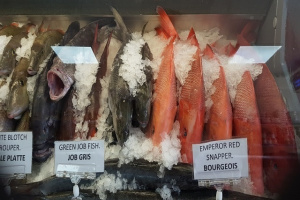Fish export business in Seychelles being squeezed by pandemic's effects
Fisheries |Author: Daniel Laurence Edited by: Betymie Bonnelame | February 3, 2021, Wednesday @ 17:33| 16209 views
Most fish exported from Seychelles are caught from the semi-industrial fishing. (Salifa Karapetyan, Seychelles News Agency)
(Seychelles News Agency) - An increase in freight prices and fewer available international flights are two of the factors negatively affecting fish exports from Seychelles as a result of the COVID-19 pandemic.
The owner of Fresh Seafood Seychelles, a fish processing and export company told SNA that "before the COVID-19 pandemic became rampant, we were exporting six days a week to our usual markets. With the current circumstances of limited flights, we are only doing it three times a week at the most."
The owner, William Jacob, said another issue is the cost of freight "which has more than double right now compared to the amount I was paying previously. It cost me $3 for a kilo in the past and now it has gone up to $7."
Although the operational cost of the company has gone up, Jacob says it is hard to increase the price of its products as demand from the international markets dwindles.
"The demand from overseas is less than 50 percent as food outlets such as restaurants closed down due to COVID-19 measures. We couldn't increase our price, in fact, we had to reduce it and we are currently navigating through a low profit margin," he added.
After five years in operation, the Fresh Seafood Seychelles is currently exporting swordfish and pelagic fish namely tuna to England, France and the United State.
A local food technologist, Neven Sinoti, from Oceana Fisheries, one of the oldest companies exporting fish, said his company is having similar constraints.
"While we are in an easier position than others as we have quite a good storage capacity, With the closing of restaurants and hotels in our foreign markets, we are also focusing on the local market to earn revenue, which is helping to keep our workers in employment," said Sinoti.
Most fish exported are caught from the semi-industrial fishing, which targets swordfish tuna and tuna-like species mostly within the Exclusive Economic Zone (EEZ) of Seychelles, an archipelago in the western Indian Ocean.
The semi-industrial sector comprises of the monofilament longline fishery operating around the Mahe plateaux. On average these vessels remain at sea for 10 days, preserving their catch on ice. According to the SFA, there are around 30 vessels that are involved in semi-industrial fishing in the island nation.
Meanwhile, the chief executive of the Seychelles Fishing Authority, Nichol Elisabeth, said that one of the main initiatives being tabled at the moment to ensure and promote a growth strategy in fish and fishery product exports bringing all players in the fisheries value chain together.
"Very often each player is working on their own or competing against each other. We want to stop this and bring the processors and exporters together. We are happy to see that FBOA is reinventing itself and trying to lead the fishermen and boat owners with the mindset to have a disciplined industry and responsible fishery," said Elisabeth.
He added that the government's message continues to be along the line of raising the profile of fishermen and all in the industry, turning fishermen into good and rich businessmen.
"We are trying to educate and pass the message that 'less is more' because quantity fishing is not necessarily the more profitable approach. Fishing the high-value species is what the government would want to encourage henceforth. We do not want to encourage mass fishing and then dump it on the local market with poor quality for a few rupees," said Elisabeth.
Back
